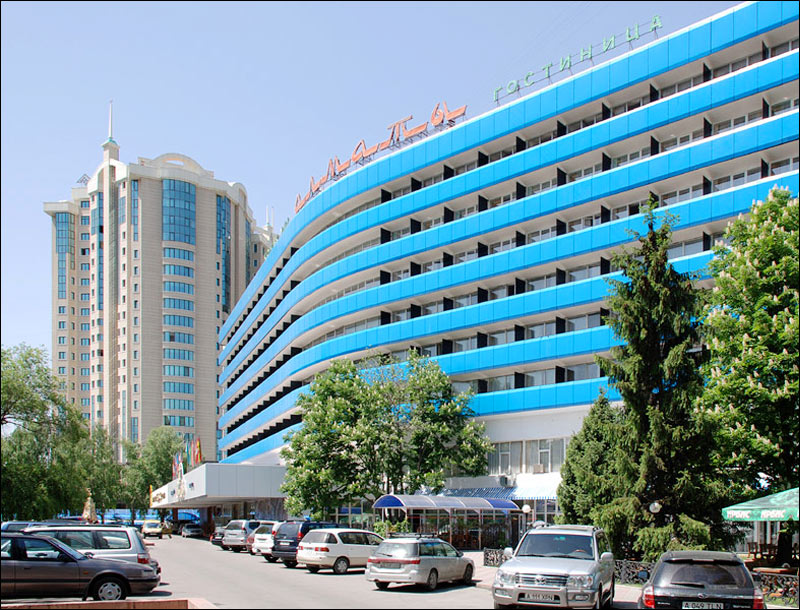I’ll hear no grumbles about bumpy flights on twin-prop planes from regional airports in the U.S., (such as Charleston’s Yeager). No sighs about the robotic sign-off from the cabin steward, “Thank you for choosing United” (as if you had a choice). No, you have no grounds for complaint because you don’t know how terrifying such flights can be. You have not had the Antonov-24 experience.
Postcards from Stanland: Journeys in Central Asia (Ohio University Press, 2016) is available from Amazon, Barnes & Noble, Books-a-Million and other online retailers. Read excerpts at www.davidhmould.com (Travel Blogs) or Facebook /PostcardsFromStanland/ or view readings and interviews on YouTube
The Antonov-24, a Soviet 44-seater turboprop which made its debut in 1959, was designed to take off and land on rough air strips in remote locations; over 800 of the aircraft manufactured are still in service, mostly in the former Soviet Union and Africa. Most look as if they have had a tough life and are ready to go into assisted living in a nice warm hangar. Despite cosmetic surgery on the wings and fuselage, the dents are visible. When you board, you just hope that the ground crew tighten up the bolts and kick the tires before take-off.
The interior décor is standard Soviet, circa 1970—fluorescent lights, faded curtains and worn carpet runners that look as if they were salvaged from the remnant section. The seats have only two positions—slightly reclined (when occupied) and fully forward. When the plane lands the backs of all seats without passengers crash forward. The overhead luggage bins are like those on trains and long-distance buses—shallow with no doors. The standard warning about opening the bins carefully “because luggage may have shifted during flight” is irrelevant. If the plane banks abruptly, all of the luggage on one side will fall out anyway.
My first flight in 2009 was from Dushanbe, the capital of Tajikistan, to Almaty in Kazakhstan, over the most spectacular mountain scenery of Central Asia—the towering Pamirs and the Tien Shan mountains, which occupy over 90 per cent of the land area of Kyrgyzstan. Flying at about 20,000 feet on a clear day, you seem to skim the tops of the snow-capped peaks. The Lonely Planet Guide to Central Asia describes the approach to Dushanbe as through—that’s through, not over—the Pamirs.
We circled three times over Dushanbe so that the pilot could gain enough altitude—and maybe enough courage—to take on the Pamirs. And then we were over them—just a few thousand feet above snowy peaks, glaciers shining bright in the morning sun, and deep in the valleys, winding dirt roads and scattered dwellings. We crossed the mountain ranges of Kyrgyzstan and then turned northeast, parallel to the Zailiysky Ala Too range, for the rest of the trip. It took almost twice as long as the outbound trip, but it was the most spectacular flight I’ve ever experienced. You don’t get views like this from a modern jet at 30,000 feet. At the time it made me almost hope they’d keep the Antonov-24 in service.
My view started to change on my second experience in 2011—a night flight from Tbilisi, the capital of Georgia, to Aktau, Kazakhstan’s main port on the Caspian Sea and the center of its (at that time) booming oil industry.
The flight was on a regional Kazakhstan airline with a disconcerting name—SCAT (probably branded in a vodka-soaked brainstorming session). The digital age had not yet arrived at SCAT; in Tbilisi, the single agent was laboriously writing down passenger names in a ledger and seat numbers on boarding cards. SCAT did not merit prime gate space. We boarded a bus that drove to the far end of the airport, and then tramped through the snow to the plane. One of the ground crew steadied the slippery, rickety steps (they looked like the aluminum steps you find in swimming pools) as we struggled on board.
There were some standard announcements over tiny speakers, almost completely drowned out by the noise of the engines. All I caught was “Uvazhayemy passazheri …Spasibo za vinimaniye” (“Dear passengers …thank you for your attention.”) Attention to what? Well, the only thing to look at during the two-hour flight (even though it left at 1:00 a.m., the fluorescent lights were on for the whole trip) were those carpet runners and the occasional swinging seat back. I was thinking about life vests. This plane was crossing the Caucasus Mountains and then the Caspian Sea. I was wondering what the flight attendant had said about the emergency exits and the “unlikely event of a water landing.” The Antonov-24 could fly, but could it float?






